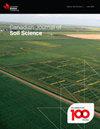Ferric chloride amendment reduces phosphorus losses from flooded soil monoliths to overlying floodwater
IF 1.5
4区 农林科学
Q4 SOIL SCIENCE
引用次数: 1
Abstract
Abstract The accumulation of phosphorus (P) in agricultural soils and subsequent losses to waterways contribute to eutrophication in surface water bodies. In agricultural lands prone to prolonged flooding during spring snowmelt, P may be released to overlying floodwater and transported to lakes downstream. Ferric chloride (FeCl3) is a potential soil amendment to mitigate P losses, but its effectiveness for flooded soils with snowmelt is not well documented. Thirty-six intact soil monoliths taken from four agricultural fields in Manitoba's Red River Valley region were surface-amended with FeCl3 at three rates (0, 2.5, and 5 Mg ha–1) to evaluate the effectiveness of FeCl3 in minimizing P losses to porewater and floodwater. Over 8 weeks of simulated snowmelt flooding, porewater, and floodwater samples taken weekly were analyzed for concentrations of dissolved reactive P (DRP), calcium (Ca), magnesium (Mg), iron (Fe), manganese (Mn), and pH. Change in the redox potential was also measured weekly. With time of flooding, redox potential decreased in all soil monoliths. At early stages of flooding, the porewater pH values were significantly lower in FeCl3-amended monoliths but increased with flooding time. Porewater and floodwater DRP concentrations increased in all soils when flooded, but the magnitudes varied. Amendment of FeCl3 decreased the DRP concentrations from 17% to 97% in porewater and 26% to 99% in floodwater, with the effectiveness varying depending on the soil, FeCl3 rate, and flooding time. Amendment of FeCl3 increased porewater concentrations of Ca, Mg, Fe, and Mn. Soil amendment with FeCl3 at both rates shows promise in mitigating redox-induced P losses from flooded soils.氯化铁改良剂减少了被淹没的土壤巨石对上覆洪水的磷损失
农业土壤中磷的积累及其对水道的损失是地表水体富营养化的原因之一。在春季融雪期间容易发生长时间洪水的农田,磷可能被释放到上覆的洪水中,并被输送到下游的湖泊。氯化铁(FeCl3)是一种潜在的土壤改良剂,可以减轻磷的损失,但其对融雪淹没土壤的有效性尚未得到很好的证明。从马尼托巴省红河谷地区的四个农田中提取了36块完整的土壤单体,用三种浓度(0、2.5和5 Mg ha-1)的FeCl3对其表面进行了修正,以评估FeCl3在减少孔隙水和洪水中磷损失方面的有效性。在8周的模拟融雪洪水中,每周采集孔隙水和洪水样本,分析溶解活性磷(DRP)、钙(Ca)、镁(Mg)、铁(Fe)、锰(Mn)和ph的浓度。每周还测量氧化还原电位的变化。随着淹水时间的延长,各土壤单体的氧化还原电位均呈下降趋势。在驱油初期,fecl3改性单体体孔隙水pH值显著降低,但随着驱油时间的延长而升高。所有土壤孔隙水和洪水DRP浓度均在淹水条件下增加,但幅度不同。FeCl3的添加使孔隙水中的DRP浓度从17%降至97%,洪水水中的DRP浓度从26%降至99%,其效果因土壤、FeCl3速率和洪水时间而异。FeCl3的加入增加了孔隙水中Ca、Mg、Fe和Mn的浓度。两种速率的FeCl3对土壤的修复显示出减轻淹水土壤氧化还原引起的磷损失的希望。
本文章由计算机程序翻译,如有差异,请以英文原文为准。
求助全文
约1分钟内获得全文
求助全文
来源期刊

Canadian Journal of Soil Science
农林科学-土壤科学
CiteScore
2.90
自引率
11.80%
发文量
73
审稿时长
6.0 months
期刊介绍:
The Canadian Journal of Soil Science is an international peer-reviewed journal published in cooperation with the Canadian Society of Soil Science. The journal publishes original research on the use, management, structure and development of soils and draws from the disciplines of soil science, agrometeorology, ecology, agricultural engineering, environmental science, hydrology, forestry, geology, geography and climatology. Research is published in a number of topic sections including: agrometeorology; ecology, biological processes and plant interactions; composition and chemical processes; physical processes and interfaces; genesis, landscape processes and relationships; contamination and environmental stewardship; and management for agricultural, forestry and urban uses.
 求助内容:
求助内容: 应助结果提醒方式:
应助结果提醒方式:


